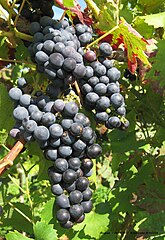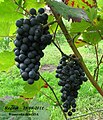Regent (grape variety)
| regent | |
|---|---|
| Synonyms | see section synonyms |
| Breeding number | Gf. 67-198-3 |

|
|
| Art | Grape vine ( Vitis vinifera subsp. Vinifera ) |
| Berry color | dark blue to violet blue |
| use | |
| origin | Germany |
| known since | 1995 |
| breeder | Gerhardt Alleweldt |
| Institute | JKI , Institute for Grapevine Breeding Geilweilerhof |
| Breeding year | 1967 |
| Launch | 1995 |
| VIVC no. | 4572 |
| ancestry | |
|
Cross between |
|
| List of grape varieties | |
The Regent is a partially resistant red wine variety with the gene locations Rpv3-1 against downy mildew ( Plasmopara viticola ) and Ren3 / Ren9 against powdery mildew ( Uncinula necator ). After the so-called old French hybrids, it is the first new fungus-resistant red wine variety that has become more widespread. It has increased resistance to the important mildew and fungal diseases of the vine. It is currently one of the most important fungus-resistant quality grape varieties in the world and delivers brightly colored, strong red wines .
Descent, origin
The Regent is a new breed (1967 cross between Diana ( Silvaner x Müller-Thurgau ) and Chambourcin ) and only received the German variety approval in 1995 and the European variety approval as well as the classification for quality wine production the following year. The family tree contains the wild species Vitis aestivalis, Vitis cinerea, Vitis labrusca , Vitis lincecumii , Vitis riparia and Vitis rupestris as well as the cultivated form Vitis vinifera . The Rpv3-1 resistance is due to Vitis rupestris . The origins of Ren3 / Ren9 are still unclear. The breeding goes back to Gerhardt Alleweldt and was developed at today's Julius Kühn Institute (JKI) Institute for Grapevine Breeding Geilweilerhof . As part of the plant variety protection approval, the variety was classified as Vitis vinifera due to its taxonomic characteristics .
The wine of the variety has a high proportion of the anthocyanin malvidin-3,5-diglucoside with up to 300 mg / l , which explains the intense color of the wine. Because of this dye, blends with Regent or other varieties with malvidin-3,5-diglucoside can be easily detected.
Ampelographic variety characteristics
- The shoot tip is open and hairy with white wool.
- The growth is medium to strong. The variety has little tendency to develop stinginess.
- The leaf is three-lobed, rarely five-lobed, the upper side bay is medium deep, the lower side bay is moderately incised, the top is blistered, small leaves are bronzed in places and hairy with white wool. The stalk bay is lyre-shaped, open to overlapping,
- The cylindrical grape is seldom shouldered, medium-sized and somewhat loose. The round to oval berries are small to medium-sized and dark blue to purple-blue in color. The juice of the berry is slightly colored.
Maturity: medium (mid-September) a little earlier than Dornfelder.
Is a wine grape that is also suitable as a table grape .
Properties, location requirements
- The variety sprouts medium early and has medium to strong growth.
- With frequent rainfall before and around the flowering period, there is an increased risk of Gescheins botrytis . The resistance to downy mildew is medium, although the leaf is less resistant. The variety requires reduced plant protection like other fungus-resistant grape varieties. There is good resistance to oidium . There is no resistance to black rot, red burner and phomopsis . The botrytis resistance is relatively high due to the loose grapes, but should not be exhausted. At the first symptoms of botrytis the grapes must be read immediately, otherwise a strong botrytis infestation can lead to the loss of the grapes within a short time . When overripe, the berries fall off easily. The variety is resistant to winter frost.
- Regent cannot do without the use of pesticides in cultivation, but the effort can be reduced by up to 70% depending on the age. One therefore no longer speaks of a fungus-resistant grape variety, but of a "fungus-resistant", abbreviated to "PiWi".
Yield
The varietal yield is between Pinot Noir and Blue Portuguese with a must weight of 80 ° to 85 ° Oechsle good locations.
distribution
Germany has the largest cultivation area with 2122 ha. There are smaller areas in Belgium, England (19 ha), Italy (3 ha), Austria, Romania (1 ha) and Hungary (3 ha). Worldwide there was a cultivation area of 2192 hectares in 2010. In 2017 it was almost 2000 hectares.
Germany
| Growing area |
Area ha |
| Germany | 1917 |
| Rhineland-Palatinate | 1452 |
| Rheinhessen | 698 |
| Palatinate | 580 |
| Near | 95 |
| Moselle | 57 |
| Ahr | 19th |
| Middle Rhine | 3 |
| Baden-Württemberg | 282 |
| Württemberg | 60 |
| to bathe | 224 |
| Bavaria | 138 |
| Francs | 135 |
| Hesse | 10 |
| Hessian mountain road | 6th |
| Rheingau | 3 |
| New federal states | 24 |
| Saale-Unstrut | 18th |
| Saxony* | 11 |
| Brandenburg | 5 |
| Mecklenburg-Western Pomerania | 2 |
| year | 1966 | 2006 | 2009 | 2015 |
|---|---|---|---|---|
| Area ha | 11 | 2183 | 2122 | 1917 |
Wine
The wine is deep red, rich in color, full-bodied, tannic material with aromas of cherries. The variety gains from aging in wooden barrels. Developed as a rosé , it delivers full-bodied wines. Regent is also a good blending partner in a cuvée .
Compared to almost all other red wine varieties, the content of the red wine pigment malvidin is above average. A high malvidin content in red wines may therefore allow conclusions to be drawn about a blend with the Regent grape variety.
Synonyms
No synonyms; Breeding numbers: Geilweilerhof 67-198-3, Gf. 67-198-3
Regent Prize
The Julius Kühn Institute's Regent Prize has been recognized as a wine competition since 2009 . Twice a year, winemakers have the opportunity to submit quality wines of the grape variety for the international competition in order to receive the quality award in gold, silver and bronze. In the first year, the gold prize was awarded a total of 20 times.
Others
Regent is a parent variety of Reberger and Calandro .
Web links
- An overview of the grape variety on the website of the German Wine Institute
- Regent in the database Vitis International Variety Catalog of the Institute for Vine Breeding Geilweilerhof (English)
literature
- Pierre Basler, Robert Scherz: PIWI grape varieties, updated edition 2011, Verlag Stutz AG, Wädenswil, ISBN 978-3-85928-086-1 .
- Pierre Galet : Dictionnaire encyclopédique des cépages . 1st edition. Hachette Livre, 2000, ISBN 2-01-236331-8 .
- Dagmar Ehrlich : The ABC of grape varieties . 1st edition. Gräfe and Unzer Verlag, Munich, 2005, ISBN 3-7742-6960-2 .
Individual evidence
- ^ Julius Kühn Institute , Institute for Grapevine Breeding Geilweilerhof : Regent grape variety . Siebeldingen 2015 ( julius-kuehn.de [PDF]).
- ↑ Hans Ambrosi , Bernd HE Hill, Erika Maul, First H. Rühl, Joachim Schmid, Fritz Schuhmann: Color Atlas Rebsorten 3rd Edition, Eugen Ulmer, 2011, ISBN 978-3-8001-5957-4 .
- ↑ K. Anderson, NR Aryal: Database of Regional, National and Global Winegrape Bearing Areas by Variety, 2000 and 2010, Wine Economics Research Center, University of Adelaide, December 2013 (first revision April 2014) (second revision May 2014) (third Revision July 2014).
- ↑ Federal Statistical Office (2016): Agriculture and Forestry, Fisheries. Agricultural land use - vineyards. Technical series 3 series 3.1.5.
- ↑ State Statistical Office Rhineland-Palatinate (2016): Statistical reports - Planted vineyards 2015. Bad Ems, CI - j / 15, reference number: C1073 201500, ISSN 1430-5070 .
- ^ German Viticulture Association (2016): 19th Special Report 2016 - Planted vineyards 2015
- ↑ Thomas Ehlke: Award for winery, Regent Award ; Verlagsgruppe Rhein Main Allgemeine Zeitung, Friday, February 5, 2010






